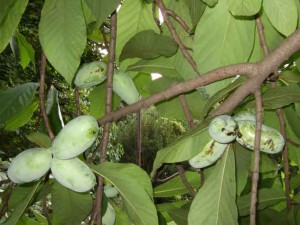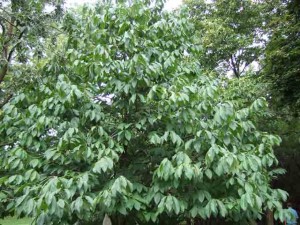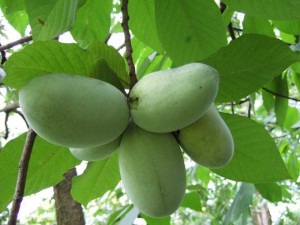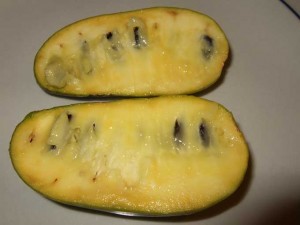I joined a group of fellow explorers from the PA Backyard Fruit Growers Association this past weekend to take part in a perilous expedition in search of wild Paw Paws in the back country of South Central, PA.
Okay, maybe it wasn’t so dangerous, and most of the Paw Paw trees were actually fairly tame and cultivated varieties rather than those growing wild, but it was still a new and interesting experience for most of our group. The BYFG Paw Paw tours take place each fall but this was my first opportunity to attend the annual outing.
Introducing the Unusual and Rare Paw Paw Tree
 If you’re not familiar with the Paw Paw don’t feel bad because they’re pretty uncommon and seldom find their way into the typical backyard landscape. They do grow wild in Pennsylvania and other areas on the East Coast, with a range that extends down into the southern states.
If you’re not familiar with the Paw Paw don’t feel bad because they’re pretty uncommon and seldom find their way into the typical backyard landscape. They do grow wild in Pennsylvania and other areas on the East Coast, with a range that extends down into the southern states.
Paw Paws are a medium sized, upright growing tree with large dark green leaves, and clusters of fruit that ripen early in the fall season. The tree is attractive and often takes on a pyramid like shape with a wide base narrowing to a peak at the top.
There are many different varieties of Paw Paws including; Sunflower, Mango, Collins Select, Pennsylvania Golden, Davis, and Rebecca’s Gold. Growers are also currently working to develop new varieties of Paw Paws in attempts to improve its growth, quality, and productivity.
Cultivating Paw Paw’s in the Home Garden
 For a plant that grows wild you would think that it would be a cinch to raise Paw Paws in the back yard or garden. Unfortunately that isn’t necessarily the case. While some gardeners are quite successful cultivating this fruit, others struggle with the temperamental and painfully slow growing plant.
For a plant that grows wild you would think that it would be a cinch to raise Paw Paws in the back yard or garden. Unfortunately that isn’t necessarily the case. While some gardeners are quite successful cultivating this fruit, others struggle with the temperamental and painfully slow growing plant.
The first challenge for the gardener is due to the Paw Paws odd cultural requirements. The plant does not take well at all to being transplanted. Then the young seedling grows best in a shady location, but for fruiting and mature growth the plant prefers to be situated in full sunshine.
So transplant paw paws with the root ball intact, provide temporary shade for the juvenile plant, grow the tree in a spot where it will receive full sun when it matures and finally, make sure your patience is high because this is a very slow growing and maturing fruit.
It appears that the location and growing environment are key considerations and that the trees appreciate a nearby water source such as a stream or spring. The paw paw seems to tolerate sharing its space with other trees, will grow in forested areas, and will spread by way of underground runners to expand its territory and produce new offspring.
Strange Sights and Odors in the Paw Paw Patch
 A mature paw paw tree can grow over twenty-five feet tall but it may take a decade to reach such lofty heights. You can enjoy your first fruits in less than half that time though, with puny little five foot tall paw paw trees straining to support a paltry crop of heavy and full-sized fruits.
A mature paw paw tree can grow over twenty-five feet tall but it may take a decade to reach such lofty heights. You can enjoy your first fruits in less than half that time though, with puny little five foot tall paw paw trees straining to support a paltry crop of heavy and full-sized fruits.
Paw Paws are also “unique” when it comes to their pollination requirements. You typically need more than one variety for pollination and paw paw flowers are described as being “dark and stinky” so good luck in getting a bee to go anywhere near this tree!
Instead paw paws are dependent on flies and beetles to do the dirty work necessary for their pollination. Some paw paw enthusiasts place road killed carcasses near their trees to help draw in the pollinators, but I think I’d test my skill at hand pollinating before resorting to more drastic measures!
Sweet Rewards for the Adventurous Fruit Seeker
If all of this paw paw discussion sounds really, really strange don’t worry, things aren’t about to change at the end of the tale. Paw paw fruits look a little bit like an elongated mango with a creamy yellow or white pulp inside. They are ripe when they begin to soften and should not be removed from the tree prior to that stage. The fruit will also fall from the tree as the ripen.
Ripe paw paw fruits are very aromatic and will quickly fill the room with an exotic and fruity aroma. Most paw paw admirers search them out or grow them not for an ornamental display, but because of the tasty fruit that’s not easy to describe or draw comparisons to.
The best comparison would be with something that’s not a fruit at all… a rich, colorful, sweet flavored custard; that’s exactly how I would describe the texture and flavor of the paw paw’s flesh. I personally like them but at least one of my co-workers that I shared the fruits with had a very different reaction and opinion (but I have to give her credit for trying it)!
Maybe it was the texture and odd consistency that she wasn’t prepared for. All I can say is that paw paws must be pretty delicious — either that or a lot of people are just as peculiar as this fruit is to go through all the effort to forage or cultivate this uncommon plant.




 Address:
Address: EMAIL:
EMAIL: Telephone:
Telephone: